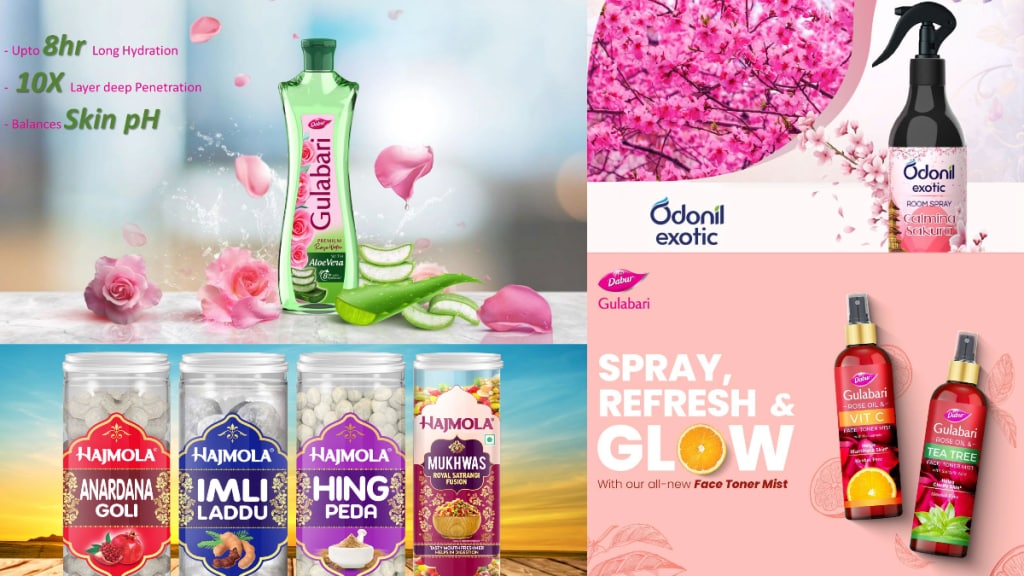What will it take for Brand X to shake off its fuddy-duddy image?
Option A: Completely change product packaging to appear hip.
Option B: Start using new-age media channels so as to meet the digital native consumers where they are expected to be.
Option C: Introduce innovative product delivery formats.
Option D: Change the brand suffix from “Lal” to “Red”.
A case-hardened marketer will tell you none of these options are going to work in isolation. But together they are capable of turning the tables.
140-year-old Dabur knows that only too well.
The company has embarked on a journey to comprehensively revamp its product portfolio. Changes include a revamp of the product mix, packaging, communication, and pushing for premiumisation across the board.
For instance, its flagship product, Dabur Amla hair oil, has undergone a packaging overhaul and has been introduced in “premium” formats like detangling sprays. The company is cross-pollinating its Vatika portfolio, a power brand overseas, into the Indian market, encompassing hair oils, shampoos, creams, and hair gels, designed to cater to the contemporary hair care consumer.
Then, a traditional product like Gulabari (rose water) is now available in the form of sprays, body washes, lotions, creams, and toners. Another product, Odomos, has been rebranded as “trendier” with fragrant lotions, patches, and roll-ons.
To reposition beverages like Real Juice for a younger audience, Dabur has introduced new varieties, PET bottles, and innovative packaging, including a carbonated version.
Dabur’s iconic products, such as Hajmola and Chyawanprash, have also seen a shift in marketing and product variants. Digestive Hajmola is now available in various formats, including mouth fresheners, anardana golis, imli laddus, and hing pedas. Chyawanprash is offered in capsules, a diabetic-friendly version, and even a jaggery-based variant. To meet the demand for scientific validation among younger consumers, Dabur is conducting clinical studies to substantiate the health benefits claimed by its products.
Experts say all this was imperative if the brand were to claw its way into the consideration set of India’s young consumer. And why is this segment important? Simple: India has more than 50% of its population below the age of 25 and more than 65% below the age of 35.
Mohit Malhotra, CEO, Dabur India, says, “While our diverse population resides in different geographic domains — be it bustling metros, serene rural areas, or vibrant tier 1 and 2 cities — their aspirations bear striking similarities, driven by global influences. We are evolving our brand to resonate with these younger consumers.” He also emphasises the importance of imbuing every brand with a meaningful purpose.
Blending new with old
Lloyd Mathias, independent director and former HP Asia marketing head, stresses that the transformation journey needs to encompass all aspects. “Old and traditional are part of the brand’s personality. The fact that the company is trying to appeal to a younger population is positive, but the overhaul has to be all-encompassing,” he says.
In all this, Dabur must strike a fine balance between legacy and modernity, says Nisha Sampath, founder of Bright Angles Consulting. “The challenge lies in expanding into multiple verticals while preserving the essence that defines Dabur, ensuring it remains relevant and appealing to both a broader audience and tomorrow’s consumers—the younger generation,” she sums up.
Therein lies Dabur’s biggest challenge. To many Indians, particularly the older generation, Dabur is synonymous with chyawanprash, rooted in the traditions of Ayurveda, evoking images of Indian sages. “This brand image, which thrives in traditional product categories, such as Chyawanprash or Lal Dant Manjan, struggles to transition into modern product categories preferred by younger consumers,” says Samit Sinha, founder and managing partner of Alchemist Brand Consulting.
Malhotra acknowledges this contradiction but maintains that this consistency is also its core strength. So while the brand will make every effort to stay in lockstep with the times, it would like to ensure it doesn’t veer off course. As an example he cites the case of Dabur Red toothpaste which has evolved from being marketed as an Ayurvedic problem-solution product to one that guarantees 12-hour freshness, with the introduction of Dabur Red Bae Fresh Gel. The company is using two ambassadors for this brand — with Amitabh Bachchan endorsing Dabur Red for older consumers and Karthik Aaryan representing Dabur Red Bae Fresh Gel to resonate with Gen Z and Millennials.
That apart, e-commerce has also taken centre stage, and accounts for approximately 10% of its overall sales.
Getting younger
- Hajmola is now available as a mouth freshener, anardana goli, imli laddu, & hing peda
- Odomos is available as a fragrant lotion, patch, and as a trendier roll-on
- Dabur Red toothpaste guarantees freshness as Dabur Red Bae Fresh Gel
- Chyawanprash is offered as jaggery-based, in capsules, and for diabetics


